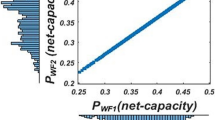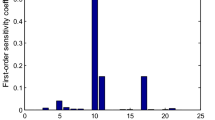Abstract
Uncertainty assessment of distribution systems performance is an obligation because of the intermittent nature of solar and wind distributed energy resources, as well as uncertainties in power demand and charging stations of electric vehicles. Consequently, efficient tools are required for load flow analysis. Many of the existing papers assume a set of given probability density functions (PDFs) to model uncertainties and develop parametric probabilistic load flow tools. However, the uncertainties might not fall in any standard class of PDFs. As a result, non-parametric tools are required. This study compares parametric and non-parametric approaches for determining the PDFs of load flow outputs, as well as Monte Carlo simulation. To compare the methods, the unscented transform and two-point estimation approaches have been considered as parametric methods, while for non-parametric methods, saddle point approximation and kernel density estimation methods have been considered. To examine the performance of the proposed parametric and non-parametric methods, IEEE 28-bus, 33-bus, 37-bus, 69-bus and 210-bus test systems are taken into consideration and results are compared with generalized Polynomial Chaos algorithm, Latin Hypercube Sampling with Cholesky Decomposition, Cornish–Fisher expansion and clustering analysis. In terms of both accuracy and execution time, the results produced by non-parametric approaches are compared to those obtained by parametric methods. They show that the non-parametric estimators produce reliable results in estimating the density function of output random variables, while can reduce the run time for the power-flow problem in an acceptable level.



Similar content being viewed by others
Abbreviations
- PV:
-
Photovoltaic
- WT:
-
Wind turbine
- EV:
-
Electric vehicle
- TPE:
-
Two-point estimation
- UT:
-
Unscented transform
- KDE:
-
Kernel density estimation
- SPA:
-
Saddle point approximation
- MCS:
-
Monte Carlo simulation
- PDF:
-
Probability density functions
- CDF:
-
Cumulative distribution function
- PLF:
-
Probabilistic load flow
- MISE:
-
Mean of square error integral
- gPC:
-
Generalized Polynomial Chaos algorithm
- LHS-CD:
-
Latin Hypercube Sampling with Cholesky Decomposition
- CFE:
-
Cornish–Fisher expansion
- CA:
-
Clustering analysis
- \({A}_{\mathrm{wt}}\) :
-
Rotor area of the wind turbine
- \({C}_{\mathrm{p}}\) :
-
Power constant
- \({f}^{\prime\prime}\) :
-
Second-order derivative of the density function f
- K(.):
-
Kernel function
- \({K}_{Y}\left(.\right)\) :
-
Cumulant generating function of variable Y
- \({{{K}}^{{\prime\prime}}}_{{Y}}\left(.\right)\) :
-
Second-order derivative of the cumulant generating function of Y
- \({M}_{X}\left(.\right)\) :
-
Moment generating function of random variable X
- \({P}_{\mathrm{r}}\) :
-
Wind power at nominal speed
- P br/Q br :
-
Re/active powers of branches
- P YY/P XX :
-
Covariance of output variable Y/input variable X
- µ load/σ load :
-
Mean value/standard deviation of the load
- h :
-
Window width
- h opt :
-
Optimal value of window width
- N :
-
Number of samples
- k w/c:
-
Shape and scale of wind speed
- \(\text{Cov}({{x}},{{y}})\) :
-
Covariance matrix
- P g/Q g :
-
Re/active power generation of power plants
- \({V}_{\mathrm{w}}\) :
-
Wind speed
- \({V}_{\mathrm{cut-in}}\) :
-
Cut-in speed
- \({V}_{\mathrm{cut-out}}\) :
-
Cut-out speed
- ρ :
-
Air density
- G ING :
-
Solar irradiation
- T c :
-
Temperature surrounding the cell
- K a :
-
Temperature coefficient for maximum power
- w 0 :
-
Weight of X0
- t s :
-
Saddle point
- μ/σ :
-
Mean value/standard deviation
- E(.):
-
Expected value
- P D :
-
Demand active power
- Q D :
-
Demand reactive power
- a/b :
-
Load's upper/lower bounds
- \({{x}}_{\text{l,k}}\) :
-
Estimated location of random variable xl
- \({{w}}_{\text{l,k}}\) :
-
Weighting factor of zl,k
- \({\xi}_{\text{l,k}}\) :
-
Standard location of zl
- \(\Phi \left(\cdot \right)\) :
-
Cumulative distribution function
- \(\phi (\cdot )\) :
-
Normal standard probability density function
- μ ε :
-
Mean relative error
- σ ε :
-
Variance relative error
- ε skewness :
-
Skewness relative error
- ε kurtosis :
-
Kurtosis relative error
References
Kavousi-Fard A et al (2015) Optimal probabilistic reconfiguration of smart distribution grids considering penetration of plug-in hybrid electric vehicles. J Intell Fuzzy Syst 29(5):1847–1855
Goodarzi S et al (2019) Efficient linear network model for TEP based on piecewise McCormick relaxation. IET Gener Trans Distrib 13(23):5404–5412
Goodarzi S et al (2020) Tight convex relaxation for TEP problem: a multiparametric disaggregation approach. IET Generat Trans Distribut 14(14):2810–2817
Faraji E et al (2021) Probabilistic planning of the active and reactive power sources constrained to securable-reliable operation in reconfigurable smart distribution networks. Electr Power Syst Res 199:107457
Davoodi A et al (2021) Multi-objective dynamic generation and transmission expansion planning considering capacitor bank allocation and demand response program constrained to flexible-securable clean energy. Sustain Energy Technol Assess 47:101469
Akbari K et al (2016) Optimal placement of distributed generation in radial networks considering reliability and cost indices. J Intell Fuzzy Syst 30(2):1077–1086
Abbasi A (2020) Investigation of simultaneous effect of demand response and load uncertainty on distribution feeder reconfiguration. IET Gener Transm Distrib 14(8):1438–1449
Abbasi A, Mahmoudi M (2021) Application of statistical control charts to discriminate transformer winding defects. Electr Power Syst Res 191:106890
Mahmoudi M et al (2021) Transformer winding faults detection based on time series analysis. IEEE Trans Instrum Meas 70:1–10
Mahmoudi MR (2021) Application of statistical control charts to discriminate transformer winding defects. Electr Power Syst Res 191:106890
Rahmani K et al (2017) Consideration effect of wind farms on the network reconfiguration in the distribution systems in an uncertain environment. J Exp Theor Artif Intell 29(5):995–1009
Liua Y et al (2016) Probabilistic load flow considering correlations of input variables following arbitrary distributions. Electr Power Syst Res 140:354–362
Wang C et al (2020) A scenario-based analytical method for probabilistic load flow analysis. Electr Power Syst Res 181:106193
Huynh VK, Ngo VD, Le DD, Nguyen NTA (2018) Probabilistic power flow methodology for large-scale power systems incorporating renewable energy sources. Energies 11(10):2624
Raykar V (2002) Probability density function estimation by different methods. ENEE 739Q(SPRING):1–8
Faraji E, Abbasi AR, Nejatian S, Zadehbagheri M, Parvin H (2022) Planning and operation of the active and reactive sources constrained to voltage security in the reconfigurable smart distribution network. JEM 12(1):16–27
Lan T, Jermsittiparsert K, Alrashood S, Rezaei M, Al-Ghussain L, Mohamed M (2021) An advanced machine learning based energy management of renewable microgrids considering hybrid electric vehicles’ charging demand. Energies 14(3):569
Abbasi AR (2022) Fault detection and diagnosis in power transformers: a comprehensive review and classification of publications and methods. Electr Power Syst Res 209:107990
Mohamed MA, Hajjiah A, Alnowibet KA, Alrasheedi AF, Awwad EM, Muyeen SM (2021) A secured advanced management architecture in peer-to-peer energy trading for multi-microgrid in the stochastic environment. IEEE Access 9:92083–92100
Wang P, Wang D, Zhu C, Yang Y, Abdullah HM, Mohamed MA (2020) Stochastic management of hybrid AC/DC microgrids considering electric vehicles charging demands. Energy Rep 6:1338–1352
Morales J, Perez-Ruiz J (2007) Point estimate schemes to solve the probabilistic power flow. IEEE Trans Power Syst 22:1594–1601
Vosoogh M et al (2014) A novel modification approach based on MTLBO algorithm for optimal management of renewable micro-grids in power systems. J Intell Fuzzy Syst 27(1):465–473
Liu J, Srikantha P (2022) Kernel Structure Design For Data-Driven Probabilistic Load Flow Studies. IEEE Trans Smart Grid. https://doi.org/10.1109/TSG.2022.3159579
Huang B, Du X (2008) Probabilistic uncertainty analysis by mean-value first order saddle point approximation. Reliab Eng Syst Saf 93(2):325–336
Abbasi AR, Khoramini R, Dehghan B, Abbasi M, Karimi E (2015) A new intelligent method for optimal allocation of D-STATCOM with uncertainty. J Intell Fuzzy Syst 29(5):1881–1888
Basil M, Jamieson A (1998) Uncertainty of complex systems by Monte Carlo simulation. In: Proceedings of the 16th North Sea flow measurement workshop, Gleneagles, UK, pp 1–10
Ansari J et al (2021) Simultaneous design of fuzzy PSS and fuzzy STATCOM controllers for power system stability enhancement. Alex Eng J 61:2841–2850
Pareek P, Wang C, Nguyen HD (2021) Non-parametric probabilistic load flow using Gaussian process learning. Phys D Nonlinear Phenom 424:132941
Kavousi-Fard A et al (2015) An smart stochastic approach to model plug-in hybrid electric vehicles charging effect in the optimal operation of micro-grids. J Intell Fuzzy Syst 28(2):835–842
Sun Y, Xia D, Gao Z, Wang Z, Li G, Lu W, Wu X, Li Y (2022) Probabilistic load flow calculation of AC/DC hybrid system based on cumulant method. Int J Electr Power Energy Syst 139:107998
Mahmoudi MR, Arefi MM (2021) Transformer winding faults detection based on time series analysis. IEEE Trans Instrum Meas 70:1–10. https://doi.org/10.1109/TIM.2021.3076835
Johnson B, Gibson NL, Cotilla-Sanchez E (2021) A Coupled Karhunen–Loève and anisotropic sparse grid interpolation method for the probabilistic load flow problem. Electr Power Syst Res 193:107044
Abbasi AR (2020) Probabilistic load flow based on holomorphic embedding, kernel density estimator and saddle point approximation including correlated uncertainty variables. Electr Power Syst Res 183:106178
Ramadhani UH, Fachrizal R, Shepero M, Munkhammar J, Widén J (2021) Probabilistic load flow analysis of electric vehicle smart charging in unbalanced LV distribution systems with residential photovoltaic generation. Sustain Cities Soc 72:103043
Abedi B, Ghadimi AA, Abolmasoumi AH, Miveh MR, Jurado F (2021) An improved TPM-based distribution network state estimation considering loads/DERs correlations. Electr Eng 103:1541–1553
Bracale A et al (2010) Point estimate schemes for probabilistic load flow analysis of unbalanced electrical distribution systems with wind farms. In: Proceedings of 14th ICHQP, Bergamo, Italia
Davoodi A et al (2022) Multi-objective techno-economic generation expansion planning to increase the penetration of distributed generation resources based on demand response algorithms. Int J Electr Power Energy Syst 138:107923
Kavousi-Fard A et al (2014) A novel adaptive modified harmony search algorithm to solve multi-objective environmental/economic dispatch. J Intell Fuzzy Syst 26(6):2817–2823
Carpinelli G et al (2015) Multi-linear Monte Carlo simulation method for probabilistic load flow of distribution systems with wind and photovoltaic generation systems. Renew Energy 76:283–295
Abbasi A, Seifi A (2008) A novel method mixed power flow in transmission and distribution systems by using master-slave splitting method. Electr Power Compon Syst 36(11):1141–1149
Augugliaro A et al (2008) A new backward/forward method for solving radial distribution networks with PV nodes. Electr Power Syst Res 78(3):330–336
Abbasi A, Seifi AR (2015) Unified electrical and thermal energy expansion planning with considering network reconfiguration. IET Gener Trans Distrib 9(6):592–601
Gruosso G et al (2019) Probabilistic load flow methodology for distribution networks including loads uncertainty. Int J Electr Power Energy Syst 106:392–400
Kabir M et al (2016) Probabilistic load flow for distribution systems with uncertain PV generation. Appl Energy 163:343–351
Shujun Y, Yan W (2011) Cornish-fisher expansion for probabilistic power flow of the distribution system with wind energy system. In: 2011 4th international conference on electric utility deregulation and restructuring and power technologies (DRPT), pp 1378–1383
Author information
Authors and Affiliations
Additional information
Publisher's Note
Springer Nature remains neutral with regard to jurisdictional claims in published maps and institutional affiliations.
Rights and permissions
About this article
Cite this article
Abbasi, A.R. Comparison parametric and non-parametric methods in probabilistic load flow studies for power distribution networks. Electr Eng 104, 3943–3954 (2022). https://doi.org/10.1007/s00202-022-01590-9
Received:
Accepted:
Published:
Issue Date:
DOI: https://doi.org/10.1007/s00202-022-01590-9




